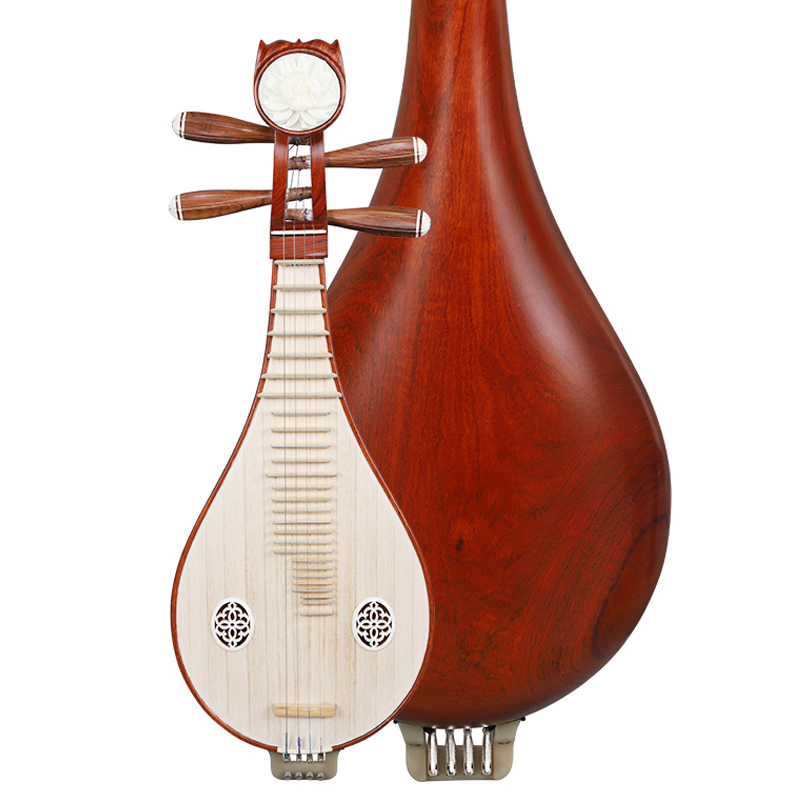Differences and differences between the four-stringed liuqin and the original liuqin
In the early 1970s, Mr. Wang Huiran further innovated and reformed the liuqin on the basis of the three-string 24-fret liuqin. He cooperated with Xuzhou National Musical Instrument Factory again, and in 1970, he successfully trial-produced the four-string twenty-nine fret. Liuqin. On the basis of the three-string twenty-four fret liuqin, a low-pitched string and five high-pitched frets are added to form a four-string twenty-nine fret liuqin. The timbre of the four-stringed liuqin is bright and beautiful, the treble is high-pitched and crisp, the midrange is soft and luscious, and the bass is thick and rough, which significantly enriches the expressive ability of the liuqin. The four-stringed liuqin is a series of reforms made on the basis of retaining the original style and advantages of the folk liuqin and according to the needs of the national orchestra to play various pieces of music. The reformed four-stringed liuqin has many advantages and is popular because it is compared with the original liuqin:

1. Improve the tuning and fix the tuning.
By shortening the body and appropriately changing the structure of the belly, the outer strings are tuned and the fourth is raised, making the liuqin a veritable high-pitched instrument. Through practice verification, it has the following advantages:
- It retains the traditional tuning style of Liuqin, that is, the fifth tuning.
- Easy to remember and play. The first and second strings are a group, the third and fourth are the lower octaves, and the fingering and interval relationship are the same.
- In the same position, an octave can be played between the first and second strings, the third and fourth strings, and the over strings are reduced.
- It is convenient to use the open strings of the tuning type, and the sound is full when playing various chords and chords, and the fingering is simple.
2. Expand the range of sound and improve the phoneme.
On the basis of the three-string twenty-four fret liuqin, a low-pitched string and five high-pitched frets are added to become a four-string twenty-nine fret liuqin. g4, up to four octaves, making it easier to play arpeggios and chords. In terms of arrangement, it is changed to twelve equal temperament, which can be adjusted at will, which is convenient for playing various commonly used chords and chords.
3. Increase the volume and beautify the sound.
The wood used to make Liuqin is changed from willow to hard and reflective mahogany. The inner chamber of the resonance box is appropriately thickened, and the space in the treble area is small and the space in the bass area is large. The inner side is slightly thinner and other measures, so that the vibration of the high and low frequencies of the four strings is basically balanced; because the silk strings are brittle, the sound is scattered, and easily broken, although the nylon strings are strong, the reverberation is small and not bright, and the pitch changes are slow when the strings are pushed and pulled. The strings are made of steel (there are also nylon steel wires), and the third and fourth strings are made of alloy winding, which makes the vibration of the strings and the resonance box better combine, increases the volume, and beautifies the sound; the flat saddle is changed to a stepped arch. The piano bridge reduces the pressure on the panel, makes the panel fully vibrate, and solves the problem of poor intonation caused by different string tensions; the original sorghum rods and bamboos are changed to bamboo with copper sheets on the surface. The sound is sensitive, wear-resistant, and prolongs its service life; the folk liuqin has no sound windows, and now there are oval sound holes on both sides of the panel, and beautiful sound windows are installed to increase the volume and reduce noise. Empty; in terms of craftsmanship and appearance, it pays attention to beauty and generosity, and is full of national characteristics. Its first-string treble area is crisp, bright and full of brilliance, with strong penetrating power. long.
4. Innovated acting skills and enhanced expressiveness.
Because the original "liuqin cover" is brittle, easy to crack, the touch point is too wide, the pronunciation is blunt, there are noises, and the skills are limited. Now using transparent celluloid (or nylon, tortoiseshell) triangular picks (about 0.7-0,8 mm thick), the picks are moderately soft and hard, full of elasticity, sharp in pronunciation, easy to control the intensity, and easy to play a variety of skills. Moreover, Liuqin has sorted out a set of standardized playing skills on the basis of drawing lessons from Chinese and foreign plucking skills. It provides a good foundation for playing various pieces of music and greatly enriches the expressive power of Liuqin. The reformed four-stringed liuqin has the above advantages, so it is widely used. It is still used in the accompaniment of local operas such as Liuqin opera in southern Shandong and northern Jiangsu and Sizhou opera in Anhui. It is convenient and the timbre is more beautiful, which can be used as a foil and embellishment for the actor's singing, so as to better exert its effect of supporting the tune and maintaining the tune. The four-string high-pitched liuqin is also widely used in solos, concertos and orchestras. It is suitable for playing splendid and highly skilled cadenza pieces in the high-pitched area. Combining water and milk blend, complement each other, play the role of foil, enhancement, contrast and decoration. In 1988, the four-string high-pitched liuqin won the highest award of the national musical instrument reform - the Science and Technology Progress Award of the Ministry of Culture.
 渝公网安备 50010702504639号
渝公网安备 50010702504639号